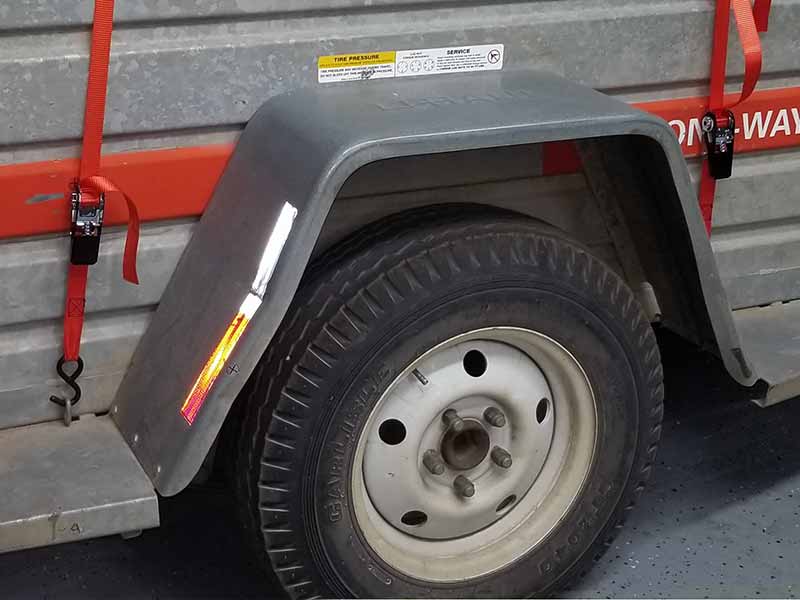Have you ever looked at your vehicle’s tires and wondered about the letters and numbers that mention load range? If you’re here, chances are you’re curious about what “Load Range C” on a tire means. It can be a crucial piece of information and important to understand.
What Is Load Range C On A Tire?
Load Range C on a tire indicates that the tire is rated for a maximum air pressure of 50 PSI for C1 or 35 PSI for C2, both with a ply rating of 6, which is suitable for certain light trucks, SUVs, and trailers.
In this article, we will explore the specifics of Load Range C tires, including their weight capacity, air pressure requirements, and the types of vehicles they are best suited for.

What Does Load Range Mean for Tires?
When we talk about tires, one term that often comes up is “load range.” This is a way to describe how much weight a tire can safely carry. It’s not something you need to think about much for a regular car, but it’s very important for bigger vehicles, like light trucks, that do heavy lifting.
Tires for Cars vs. Tires for Light Trucks
There are two main types of tires to know about:
- Passenger Tires: These are for everyday cars. They’re made for a comfortable drive and don’t need to focus on carrying heavy loads.
- Light Truck Tires: These are the stronger tires, marked with “LT.” They’re for bigger vehicles that need to carry heavy things or drive in tough conditions.
Why Load Range Matters
Load range is key for a few reasons:
- Strength: A tire with the right load range can carry heavy weights safely.
- Durability: Choosing the correct load range helps your tires last longer because they’re not being overworked.
- Safety: The right load range is crucial for safe driving. If a tire is overloaded or not inflated properly, it could fail and cause an accident.
To sum it up, load range is all about the tire’s ability to carry weight and handle heavy loads. For vehicles that work hard and carry more, like light trucks, picking the right load range is essential for safety and keeping your tires in good shape.
Load Range and Ply Rating Chart
| Load Range | Ply Rating | Max Load Carrying Air Pressure |
| Standard Load (SL) | 4 | @ 36 PSI |
| Extra Load (XL) | 4 | @ 42 PSI |
| C1 | 6 | @ 50 PSI |
| C2 | 6 | @ 35 PSI |
| D1 | 8 | @ 65 PSI |
| D2 | 8 | @ 50 PSI |
| E1 | 10 | @ 80 PSI |
| E2 | 10 | @ 65 PSI |
| F1 | 12 | @ 95 PSI |
| G | 14 | @ 110 PSI |
Understanding Load Range C on Tires
In the tire industry, Load Range C is a term you’ll come across, particularly when looking at tires for smaller trucks and utility trailers. It’s a key detail that tells you about the tire’s capacity. Let’s simplify this concept.
Load Range C and Weight Capacity
Load Range C is directly related to how much weight a tire can handle. It specifies the maximum weight a tire can carry at its optimal air pressure. This is crucial for smaller vehicles or trailers that need to carry moderate loads.
Load Range C Weight Capacity: Generally, a Load Range C tire can support a weight of about 1,360 to 1,870 lbs per tire when fully inflated. This capacity ensures that the tire can bear the weight without suffering damage or excessive wear.
It’s my recommendation to always account for the total weight your vehicle will carry, including all passengers, cargo, and any additional equipment. This helps in choosing a tire that can manage the load without being compromised.
Ply Rating and Load Range C
Historically, the strength of a tire was determined by the number of layers, or plies, it had. More plies meant a stronger tire. Nowadays, the construction of tires has improved, but we still use ply rating as a measure of strength.
Load Range C Ply Rating: Tires with a Load Range C are often described as “6 ply rated.” This doesn’t mean the tire actually has six layers. Rather, it signifies that the tire has the equivalent strength of the old 6-ply design.
I often explain to customers that the ply rating is a good indicator of a tire’s robustness and ability to endure stress and weight.
Recommended Tire Pressure for Load Range C
Each tire has an ideal pressure that allows it to work best.
Load Range C Tire Pressure: These tires typically require about 50 PSI to perform correctly. However, the ideal pressure might change depending on the tire’s brand, model, and the vehicle’s weight.
A common issue I encounter is tires that aren’t inflated enough. Keeping your tires at the proper pressure is important for safety, fuel efficiency, and extending the tire’s life.
Speed Rating and Load Range C
The speed rating tells you the highest speed a tire can safely maintain.
Load Range C Speed Rating:
- M: Up to 81 mph (130 km/h)
- N: Up to 87 mph (140 km/h)
- P: Up to 93 mph (150 km/h)
These tires are typically designed for vehicles that don’t need to go very fast but do need to carry weight reliably. They’re made to be durable and strong, rather than for high-speed performance.

Load Range C1 vs. C2
Load Range C1 and C2 are classifications within the Load Range C category, and they signify different levels of weight capacity and air pressure:
- C1: This designation means “Load Range C1” and is associated with a maximum air pressure of 50 PSI. It’s suitable for vehicles that have a single tire on each end of an axle and are rated as 6-ply tires.
- C2: “Load Range C2” indicates a maximum air pressure of 35 PSI. These are also 6-ply rated but are designed for dual-tire setups, which are common on some larger vehicles that require two tires on each end of an axle for additional support.
Key Differences
Maximum Air Pressure:
- C1: Can handle up to 50 PSI, allowing for a higher carrying capacity within the Load Range C classification.
- C2: Has a lower maximum air pressure of 35 PSI, which is still adequate for dual-tire configurations on larger vehicles.
Vehicle Application:
- C1: These tires are typically used on smaller trucks, SUVs, and vans that do not require the additional support of a dual-tire setup.
- C2: Suited for larger vehicles that carry heavier loads and therefore benefit from the stability that dual tires provide.
Ply Rating: Both C1 and C2 are 6-ply rated, which means they have the strength equivalent to what was traditionally a 6-ply tire. This rating indicates a robust construction suitable for medium-duty applications.
When selecting tires, it’s crucial to match the Load Range with your vehicle’s requirements. Using a tire with an inappropriate Load Range can lead to tire overloading, affecting safety and tire longevity.

Load Range C vs. Load Range B
Load Range C tires are designed to support more weight than Load Range B. Here’s how they compare:
- Weight Capacity: Load Range C tires have a higher weight capacity than Load Range B, making them suitable for vehicles that carry more weight.
- Ply Rating: Load Range C tires are typically “6 ply rated,” indicating they are stronger than the “4 ply rated” Load Range B tires.
- Usage: Load Range B is more common for lighter vehicles and smaller trailers, while Load Range C is suited for heavier loads, such as larger trailers and some light-duty trucks and vans.
Load Range C vs. Load Range D
Comparing Load Range C to Load Range D:
- Weight Capacity: Load Range D tires have a higher weight capacity than Load Range C, which means they can handle heavier vehicles or loads.
- Ply Rating: While Load Range C tires are “6 ply rated,” Load Range D tires are typically “8 ply rated,” suggesting they have the strength equivalent to an older 8-ply tire.
- Usage: Load Range C is commonly used for medium-duty tasks and vehicles, including some light trucks, SUVs, and vans. Load Range D, on the other hand, is for heavier-duty applications, suitable for larger trucks, SUVs, and vans that tow or carry heavier cargo.
Resources
Below are some links you may find helpful when learning about tires:
Final Thoughts
Understanding tire load ranges, especially Load Range C, is not about the fit; it’s about the tire’s ability to handle the weight of your vehicle and its cargo. Always consult with a tire professional if you’re unsure about the specifications for your vehicle, and remember to check your tire sidewalls for the correct load range.
Good luck and happy motoring.





